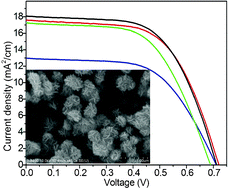Application of hierarchical TiO2 spheres as scattering layer for enhanced photovoltaic performance in dye sensitized solar cell†
Abstract
Hierarchical TiO2 spheres (HTSs) composed of thin

* Corresponding authors
a
College of Chemistry and Chemical Engineering, Henan Normal University, Xinxiang 453007, Henan, P. R. China
E-mail:
jiangkai6898@126.com
Fax: +86 373 3326209
b Collaborative Innovation Center of Motive Power & Key Materials, Henan, P. R. China
c Key Laboratory of Photovoltaic Materials of Henan Province, Xinxiang, Henan 453007, P. R. China
Hierarchical TiO2 spheres (HTSs) composed of thin

 Please wait while we load your content...
Something went wrong. Try again?
Please wait while we load your content...
Something went wrong. Try again?
Z. Gao, Z. Wu, X. Li, J. Chang, D. Wu, P. Ma, F. Xu, S. Gao and K. Jiang, CrystEngComm, 2013, 15, 3351 DOI: 10.1039/C3CE27098J
To request permission to reproduce material from this article, please go to the Copyright Clearance Center request page.
If you are an author contributing to an RSC publication, you do not need to request permission provided correct acknowledgement is given.
If you are the author of this article, you do not need to request permission to reproduce figures and diagrams provided correct acknowledgement is given. If you want to reproduce the whole article in a third-party publication (excluding your thesis/dissertation for which permission is not required) please go to the Copyright Clearance Center request page.
Read more about how to correctly acknowledge RSC content.
 Fetching data from CrossRef.
Fetching data from CrossRef.
This may take some time to load.
Loading related content
